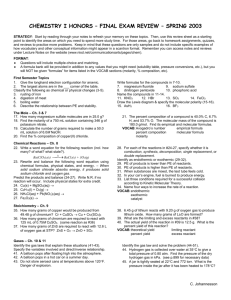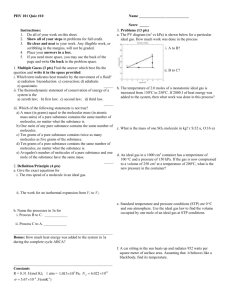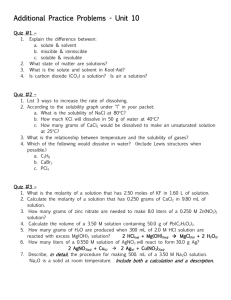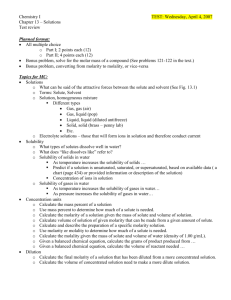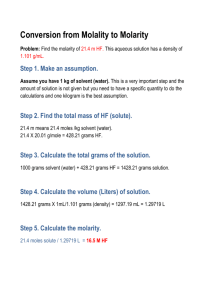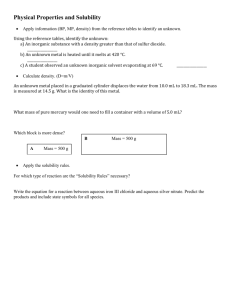CHEMISTRY– FINAL EXAM REVIEW STRATEGY: Start by reading
advertisement
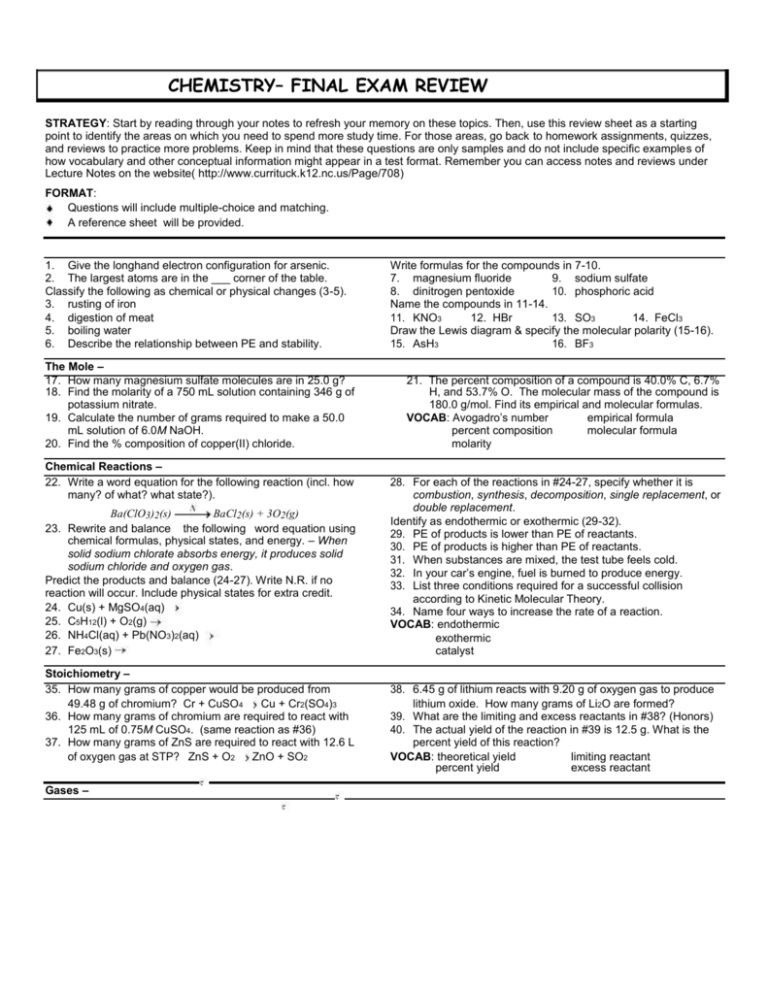
CHEMISTRY– FINAL EXAM REVIEW STRATEGY: Start by reading through your notes to refresh your memory on these topics. Then, use this review sheet as a starting point to identify the areas on which you need to spend more study time. For those areas, go back to homework assignments, quizzes, and reviews to practice more problems. Keep in mind that these questions are only samples and do not include specific examples of how vocabulary and other conceptual information might appear in a test format. Remember you can access notes and reviews under Lecture Notes on the website( http://www.currituck.k12.nc.us/Page/708) FORMAT: Questions will include multiple-choice and matching. A reference sheet will be provided. 1. Give the longhand electron configuration for arsenic. 2. The largest atoms are in the ___ corner of the table. Classify the following as chemical or physical changes (3-5). 3. rusting of iron 4. digestion of meat 5. boiling water 6. Describe the relationship between PE and stability. The Mole – 17. How many magnesium sulfate molecules are in 25.0 g? 18. Find the molarity of a 750 mL solution containing 346 g of potassium nitrate. 19. Calculate the number of grams required to make a 50.0 mL solution of 6.0M NaOH. 20. Find the % composition of copper(II) chloride. Chemical Reactions – 22. Write a word equation for the following reaction (incl. how many? of what? what state?). Ba(ClO3)2(s) BaCl2(s) + 3O2(g) 23. Rewrite and balance the following word equation using chemical formulas, physical states, and energy. – When solid sodium chlorate absorbs energy, it produces solid sodium chloride and oxygen gas. Predict the products and balance (24-27). Write N.R. if no reaction will occur. Include physical states for extra credit. 24. Cu(s) + MgSO4(aq) 25. C5H12(l) + O2(g) 26. NH4Cl(aq) + Pb(NO3)2(aq) 27. Fe2O3(s) Stoichiometry – 35. How many grams of copper would be produced from 49.48 g of chromium? Cr + CuSO4 Cu + Cr2(SO4)3 36. How many grams of chromium are required to react with 125 mL of 0.75M CuSO4. (same reaction as #36) 37. How many grams of ZnS are required to react with 12.6 L of oxygen gas at STP? ZnS + O2 ZnO + SO2 Gases – Write formulas for the compounds in 7-10. 7. magnesium fluoride 9. sodium sulfate 8. dinitrogen pentoxide 10. phosphoric acid Name the compounds in 11-14. 11. KNO3 12. HBr 13. SO3 14. FeCl3 Draw the Lewis diagram & specify the molecular polarity (15-16). 15. AsH3 16. BF3 21. The percent composition of a compound is 40.0% C, 6.7% H, and 53.7% O. The molecular mass of the compound is 180.0 g/mol. Find its empirical and molecular formulas. VOCAB: Avogadro’s number empirical formula percent composition molecular formula molarity 28. For each of the reactions in #24-27, specify whether it is combustion, synthesis, decomposition, single replacement, or double replacement. Identify as endothermic or exothermic (29-32). 29. PE of products is lower than PE of reactants. 30. PE of products is higher than PE of reactants. 31. When substances are mixed, the test tube feels cold. 32. In your car’s engine, fuel is burned to produce energy. 33. List three conditions required for a successful collision according to Kinetic Molecular Theory. 34. Name four ways to increase the rate of a reaction. VOCAB: endothermic exothermic catalyst 38. 6.45 g of lithium reacts with 9.20 g of oxygen gas to produce lithium oxide. How many grams of Li2O are formed? 39. What are the limiting and excess reactants in #38? (Honors) 40. The actual yield of the reaction in #39 is 12.5 g. What is the percent yield of this reaction? VOCAB: theoretical yield limiting reactant percent yield excess reactant Gases – Ch. 10 & 11 (continued) 46. 300.0 mL of gas has a pressure 75.0 kPa. When the volume is decreased to 125.0 mL, what is its pressure? 47. 48. 50.0 L of gas has a temperature of 75 C. What is the temp in Celsius when the volume changes to 110 L? 49. What is the volume of a container that holds 48.0 g of helium at a pressure of 4.0 atm and temperature of 52 C? 50. Liquids & Solids – Identify each intermolecular force described in 55-58. 55. Attraction between any two polar molecules. 56. Very weak force that increases with molar mass. 57. Attraction between two momentary dipoles. 58. Very strong attractive force between molecules with N-H, O-H, or F-H bonds. 60. Compare and contrast liquids and solids. Identify each type of solid in 61-65. 61. Every atom is covalently bonded to another atom. 62. Atoms are surrounded by a sea of electrons. 63. Particles are connected only by IMF. 64. 65. Charged particles in a geometric pattern. Solutions – 73. Explain the effect of adding more solute to unsaturated, saturated, and supersaturated solutions. 51. A gas occupies 325 L at 25 C and 98.0 kPa. What is its volume at 70.0 kPa and 15 C? 52. What volume of SO2 is produced from 32.5 g of ZnS at 23 C and 103.3 kPa? ZnS + O2 ZnO + SO2 53. Define real gases. When do they act like ideal gases? 54. VOCAB: Kelvin STP 66. Explain the relationship between strong intermolecular forces and the following properties – volatility, vapor pressure, and boiling point. 67. Read vapor pressure graphs (See Changes of State w/s or Liquids & Solids Quiz.) Indicate whether a heating curve would be flat or rising in 68-72. 68. liquid is boiling 71. potential energy is increasing 69. solid is warming 72. kinetic energy is increasing 70. solid is melting VOCAB: surface tension crystalline vs. amorphous capillary action sublimation volatility heat capacity vapor pressure heat of fusion boiling point heat of vaporization 81. What volume of 12M HCl is needed to prepare 250 mL of 0.20M HCl? 74. Explain how temperature and pressure affect solubility. State whether each pair is soluble or insoluble (75-78). 82. 75. KCl in water 83. 77. wax in C6H6 76. ammonia in oil 78. CH4 in water 79. Read solubility curves (See Nature of Solutions w/s and Solutions Quiz). 80. How many grams of AlCl3 are required to make a 2.25M solution in 30.0 g of water? Acids and Bases – State whether the following are acids or bases (85-88). 85. Have a sour taste. 87. Feel slippery 86. React with metals. 88. Turn blue litmus paper red. 84. VOCAB: solvation dissociation molality solubility ionization strong/weak/nonelectrolyte 94. Find the molarity of a KOH solution with a pH of 9.5. 95. Is the solution in #94 acidic or basic? 96. When a neutralization reaction between a strong acid and a 89. 90. diffusion effusion weak base reaches the equivalence point, will the solution be acidic, basic, or neutral? 97. 91. 92. 93. Find the pH of 0.75M HCl. Nuclear Chemistry – 98. Match each description with the appropriate type of radiation – alpha, beta, positron, or gamma (99-103). 99. A negatively charged electron. 103. Radiation energy with no electrical charg3 Write equations for the nuclear decay reactions in 104-108. 104. Decay of polonium-218 by alpha ( ) emission. 105. Decay of sodium-22 by electron capture. 106. Decay of carbon-14 by beta ( -) emission. 107. Decay of chlorine-32 by positron ( +) emission. 108. Carbon-14 has a half-life of 5,730 years. If a plant contained 2.0 g of 14C when it died, how much is left after 34,380 years? – FINAL EXAM REVIEW ANSWER KEY 1. 2. 3. 4. 5. 6. 7. 8. 11. 12. 13. 14. 15. 16. 17. 18. 19. 20. 21. 22. 1s22s22p63s23p64s23d104p3 bottom-left chemical chemical physical low PE = high stability MgF2 9. Na2SO4 N2O5 10. H3PO4 potassium nitrate H N H hydrobromic acid sulfur trioxide iron(III) chloride H polar (see diagram) nonpolar (see diagram) F B F 1.25 10 23 molecules MgSO4 4.6M KNO3 F 12 g NaOH 47.27% Cu, 52.73% Cl empirical formula – CH2O, molecular formula – C6H12O6 One unit of solid barium chlorate when heated produces one unit of solid barium chloride and three molecules of oxygen gas. 2NaClO3(s) 2NaCl(s) + 3O2(g) Cu(s) + MgSO4(aq) N.R. C5H12(l) + 8O2(g) 5CO2(g) + 6H2O(g) 2NH4Cl(aq) + Pb(NO3)2(aq) 2NH4NO3(aq) + PbCl2(s) 2Fe2O3(s) 4Fe(s) + 3O2(g) single replacement, combustion, double replacement, decomposition 29. exothermic 31. endothermic 30. endothermic 32. exothermic 23. 24. 25. 26. 27. 28. 33. particles must collide, they must collide at the proper orientation, they must collide with sufficient KE 34. increase the surface area by grinding or dissolving the solid in water, increase the concentration of the reactants, increase the temperature of the reactants, use a catalyst 35. 2Cr + 3CuSO4 3Cu + Cr2(SO4)3, 90.71 g Cu 36. 37. 38. 39. 40. 41. 42. 43. 44. 45. 46. 47. 48. 49. 50. 51. 52. 3.3 g Cr 2ZnS + 3O2 2ZnO + 2SO2, 36.5 g ZnS 4Li + O2 2Li2O, 13.9 g Li2O limiting reactant – Li, excess reactant – O2 89.9% yield Boyle’s Law, P&V, inverse Charles’ Law, V&T, direct Gay-Lussac’s Law, P&T, direct Dalton, 75.5 kPa Gay-Lussac, 1180 torr Boyle, 180. kPa Graham, 28.0 g/mol Charles, 490 C Ideal, 80. L Graham, 333 m/s Combined, 440. L 7.95 dm3 SO2 (or 7.93 dm3 SO2) 53. Real gas molecules have a volume and attract each other. They act ideal at high temperatures and low pressures. 54. Greater molar mass = slower rate of diffusion 55. dipole-dipole 57. dispersion 56. dispersion 58. hydrogen bond 59. CH4 – dispersion SCl2 – dispersion, dipole-dipole F2 – dispersion NH3 – dispersion, dipole-dipole, hydrogen bond 60. Both are incompressible with high density. Liquids are fluids. Solids have stronger IMF and slower diffusion. 61. covalent network crystal 62. metallic crystal 63. covalent molecular crystal 64. amorphous 65. ionic crystal 66. Strong IMF means molecules want to stay in the liquid state so volatility is low. Since there are fewer vapor molecules, v.p. is low. The b.p. is high because higher temps are needed to overcome the strong forces. 67. See w/s and quiz. 68. flat 71. flat 69. rising 72. rising 70. flat 73. Unsaturated – solute will dissolve. Saturated – solute will not dissolve. Supersaturated – rapid crystallization. 74. Solubility of gases increases with low temps & high pressure. Solubility of solids increases with high temps. 75. soluble (P/P) 77. soluble (NP/NP) 76. insoluble (P/NP) 78. insoluble (NP/P) 79. See worksheet and quiz. 80. 9.00 g AlCl3 81. 4.2 mL 12M HCl 82. Molarity – measure amount of solute, add enough water to reach the desired volume. Molality – measure amount of solute, measure kg of water, combine. 83. C12H22O11 – 1, MgBr2 – 3, AlCl3 – 4, NH4NO3 – 2 84. – 4.8 C 85. acid 87. base 86. acid 88. acid 89. Arr acid – forms H3O+ in water. Arr base – forms OH– in water. B-L acid – proton donor, B-L base – proton acceptor. Lewis acid – e- pair acceptor, Lewis base – e- pair donor. 90. A, B, CB, CA 91. NH4+ and HBr H2O and SO42– 0.12 3.2 × 10-5 M KOH (pOH = 4.5) basic acidic 0.13M Ca(OH)2 -11 J 98. 0.112353 amu, 1.68 10 99. beta 102. alpha 100. gamma 103. gamma 101. positron 104. 218 4 214 84 Po 2 He 82Pb 105. 22 0 22 Na e Ne 92. 93. 94. 95. 96. 97. 106. 107. 11 1 10 14 6 0 14 7 C 1 e N 0 32 17 Cl 1 e 16 S 32 108. 0.63 g
